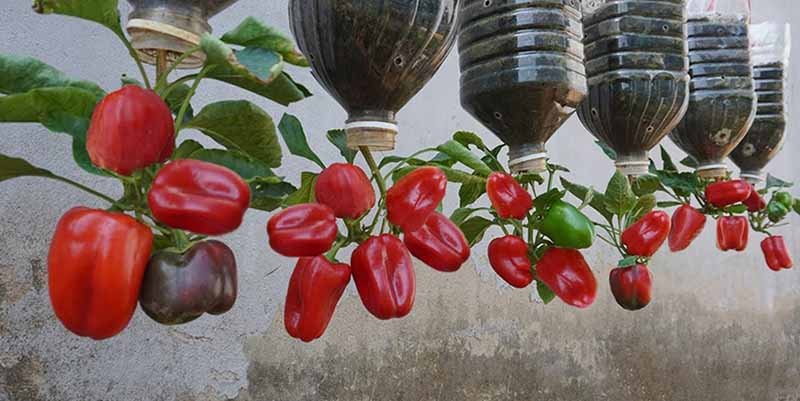Do you dream of tasting fresh and flavorful peppers, picked straight from your garden?
Then this article is for you! Follow this comprehensive guide to learn how to plant and cultivate peppers successfully and become a true expert in the field.
- Choose pepper varieties that suit your needs
Before you start growing peppers, it’s essential to choose the variety or varieties that best suit you.
Indeed, there are many pepper varieties with diverse characteristics in terms of taste, shape, size, and color. Generally, sweet peppers are ideal for salads and Mediterranean cuisine, while hot peppers are used for adding spice to dishes.
Depending on your desires and culinary needs, you can opt for varieties such as the California Wonder pepper, which is widespread and appreciated for its thick and juicy flesh, the elongated Marconi pepper, ideal for grilling, or the Espelette chili pepper to add a spicy touch to your preparations.
- Start pepper seedlings indoors
The first step to successfully grow peppers is to sow seeds indoors, usually between February and April.
Peppers require warmth to germinate and develop, with the ideal temperature around 25°C. Here’s how:
- Fill pots or trays with lightly compacted seed starting soil.
- Place your pepper seeds on the surface of the potting soil, spacing them about 2 cm apart.
- Cover the seeds with a thin layer of potting soil, then gently water using a sprayer.
- Position your seedlings near a heat source (radiator, heated greenhouse) and provide them with adequate light, ensuring a constant temperature and sufficient humidity.
After 2 to 3 weeks, the pepper seeds should germinate, and the first sprouts will appear. Don’t hesitate to transplant them individually into larger pots if they become too crowded, being careful to handle them delicately to avoid damaging the roots.
- Transplant peppers outdoors
Once the risk of frost has passed, usually from mid-May onwards, you can transplant your pepper plants outdoors, either directly into the ground or in containers or pots on your terrace or balcony.
Here are some tips to successfully complete this crucial step:
- Choose a sunny location protected from the wind, as peppers need warmth and light to develop properly.
- Prepare the soil by enriching it with compost or well-decomposed manure, then loosen it using a fork or rake.
- Space your pepper plants about 50 cm apart in all directions to give them enough room to grow and flower.
- Water your pepper plants thoroughly after planting to promote rooting and alleviate transplant stress.
If you’re growing your peppers in containers, make sure to choose pots that are at least 30 cm in diameter and depth, and fill them with a mix of potting soil and compost.
- Maintain and care for your pepper plants
The success of your pepper cultivation also depends on proper maintenance throughout the season.
Here are some essential steps to care for your plants and ensure their proper development:
- Watering: Peppers need cool, moist but not waterlogged soil. Water them regularly, being careful not to wet the leaves to prevent diseases. In hot climates, mulching with straw, grass clippings, or wood chips can be beneficial to retain soil moisture.
- Staking: To prevent your pepper plants from falling due to the weight of the fruit, consider tying them to stakes or supporting them with nets or cages.
- Sucker removal: To promote fruiting, it’s recommended to remove suckers, which are small side shoots that appear between the main stem and branches. Simply pinch them off with your fingers or cut them with clean and disinfected pruners.
- Plant pruning: Towards the end of the season, don’t hesitate to prune the tips of the branches on your pepper plants to stimulate the ripening of the remaining fruits and facilitate harvesting.
Finally, to prevent diseases and pest attacks, adopt a preventive approach by promoting biodiversity within your garden (hedges, pollinator-friendly flowers, insect hotels) and ensuring the good health of your plants (watering, fertilization, and proper airflow).
- Harvest and store your peppers
Peppers are typically harvested between July and October, when the fruits have reached their final size and color.
To do so, simply cut the peppers with pruning shears, leaving a small portion of the stem attached. You can then store them for a few days at room temperature or place them in the refrigerator for longer storage.
If you want to preserve your peppers for the winter, you have several options:
- Freezing: Wash, remove the seeds, and cut the peppers into strips or cubes, then place them in freezer bags.
- Canning: Prepare sterilized jars and fill them with pepper strips, then cover with olive oil and some herbs (garlic, thyme, bay leaves).
- Drying: Slice your peppers into thin strips and dry them in the sun, a dehydrator, or in the oven at a low temperature, then store them in an airtight jar.
By following these tips, you’ll be able to enjoy your peppers all year round and add a colorful and flavorful touch to your dishes.
In conclusion, planting and growing peppers is not an insurmountable task, as long as you follow the key steps and adopt good practices. So don’t hesitate any longer, embark on this adventure, and savor the pleasure of tasting your own peppers, freshly picked from your garden!
